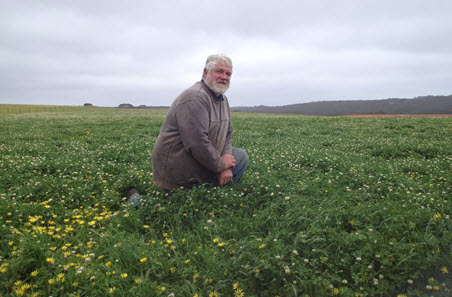Making good pasture investments
13 December 2018
The first indication that there was a problem on the Hams’ Kangaroo Island farm was that lambing percentages dropped to around 25%. The ewes were in good condition and, while the pastures looked fine, the problem was soon identified as being oestrogenic clovers.
That was 38 years ago.
At the time, PIRSA researchers David Little and David Woodard were working on a research project on renovating oestrogenic pastures on Kangaroo Island and they identified the problem and mapped the oestrogenic clovers on the Hams’ farm.

“The percentages were pretty ugly,” David Woodard said.
“The paddocks ranged from 4% to 59% oestrogenic clovers. We work on anything above about 20% as posing a risk. Back in those days on the Hams’ place, we found that out of 13 paddocks, nine were high or very high and only two were totally safe.”
David Woodard returned to the Hams’ farm in October this year to conduct a field walk organised by Agriculture Kangaroo Island (AgKI), MacKillop Farm Management Group (MFMG) and MLA, who have partnered together on a new project called Good Clover, Bad Clover. The project will work closely with local producers to determine what constitutes good and bad clover and how to implement effective management of clovers.
Bad clovers and fertility problems
Oestrogenic clovers – the bad clovers – are Dinninup, Dwalganup, Yarloop and Geraldton. These older varieties contain high levels of the isoflavone formononetin, which leads to fertility problems in ewes. The effect is cumulative, so lambing percentages will continue to drop from one year to the next.
“Wethers may also experience problems on oestrogenic clovers over time due to enlarged bulbo-urethral glands which may lead to death,” David said.
“Wethers to be sold as prime lamb can be run on the oestrogenic clovers because they aren’t on the pasture for long enough to have any problems.
“Ewes may fail to conceive or abort before full term. Conception rates will vary and a wide spread of lambing time may occur within the flock. Rams are the only sheep not affected by the bad clovers.
“Pastures can be renovated and Rob Hams is doing a good job renovating his."
Rob said the process of renovating the affected pastures takes several years. The enterprise's lambing percentages are now back up to around 80%.
“We began renovating them by cropping the paddocks two years in a row,” he said.
So far, 180ha has been renovated with Rob admitting the significant investment and taking those paddocks out of grazing rotation does slow the process.
“We sprayed out the clover at seeding and then sprayed again over the top of the crop. Then in the third year, we knocked the paddock again before reseeding it with two sub-clovers and balansa. It seems to be going alright but we had to reduce stock to be able to do it.
“The new cultivars that we've sown are producing better quality and quantity of feed, but we've only had stock running on it for a year because we had to let the seed bank establish.
“In the early days, we just managed the oestrogenic pastures we had by running cattle or wethers on them, rather than trying to renovate them. We’ve also run our older ewes on them and accepted lower lambing percentages in that mob. The oestrogenic clovers can also be grazed safely by ewes when the grass is completely dry."
The good news is there are management strategies available to producers, which include:
1. Understand the issue
- Analyse each paddock to assess farm-scale prevalence of problem clovers.
2. Graze strategically
- Avoid grazing ewes on oestrogenic clovers before or during mating, as clover can cause temporary infertility.
- Avoid long-term exposure of ewes to large amounts of oestrogenic clovers, as this can cause permanent infertility. This cumulative effect can occur over two to three years’ exposure.
- Reserve high-oestrogenic clovers to finish terminal lambs or cattle which are not affected.
- Graze weaner and young ewes on the least oestrogenic pastures available.
- As the plant senesces (dies off), isoflavones break down and plant material becomes safe for grazing ewes.
- Avoid cutting hay and silage from oestrogenic clover paddocks, because fodder cut at the ideal time before clover has senesced is still problematic.
3. Manage pastures
- Dilute clover-based pastures with newer, non-oestrogenic clovers or other pasture species.
- Develop a long-term strategic spraying and grazing program with an agronomist to prevent clover seed-set and reduce the seed bank.
- Buy certified clover seed to ensure it does not contain older varieties.
- Be aware that purchased hay or silage for feeding ewes could contain high-oestrogenic clovers.
More information:
Click here for a fact sheet on identifying bad clovers.
Robert Hams
E: rjhams@bigpond.com
David Woodard, PIRSA
M: 0417 803 525
E: david.woodard@sa.gov.au
Lyn Dohle, PIRSA
P: 08 8553 4999
E: lyn.dohle@sa.gov.au


